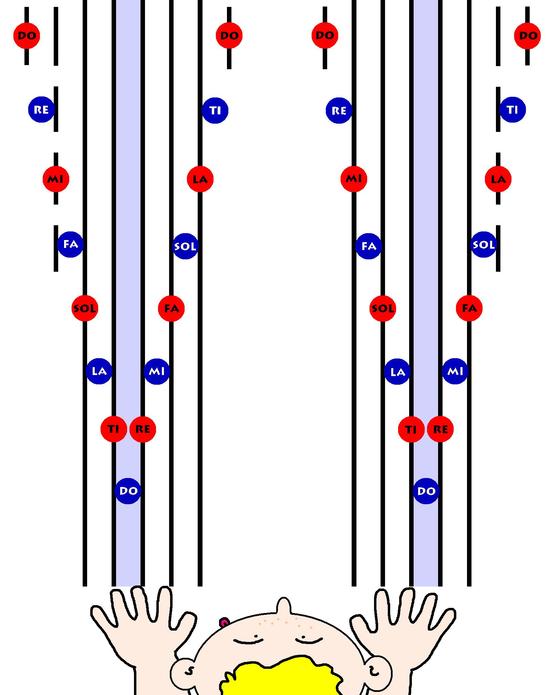Preparatory C (from 5+). Lesson 31

Your FREE Demo version is here
Your full version access is here
Today I have very special information for you: how to teach your toddlers to see the music notation on the piano keys. Today in our Pedagogy Class:
When teaching your toddler at home always remember that ...
Notes and keys hook together through lines and spaces more obviously than by the note’s name on a scale and keys
Most methods of teaching music have always focused on the differences in similar looking notes and keys.
They start teaching the patterns of octaves, for example. They offer different strategies of matching each note from the score to the piano keys by having students--
- Remember phrases such as Every Good Boy Does Fine
- Color code or picture code each note/key of the octave differently
- Give different names to notes/keys.
If this works, why do we need the Music Staff? Just place the different-looking notes on one line and try to read music! It won’t get you any closer to sight-reading though!
In fact, all fluent readers don’t have time to stop and think about the name/color/picture associated with every note. They grasp music text visually, based on their notes’ position on the lines and spaces.
Until today we also were mostly working on different looking pictures and their names. Time to move on to the more advanced level!
The visual position of notes – this is what makes the difference.
In the illustration below:
Blue is the color of all space notes.
Red is the color of all line notes.
A bluish tint marks the space between the third and fourth lines, since this is the beginning of the next octave.
As you may see there are many Do, Re and Mi etc. notes, but only 5+5 stripes (lines).
Focusing on these stripes/lines will save you and your toddler time in connecting 1+1.
1. We continue to improve the game of arpeggios
2. Exercises for setting the hands of Olga Mikhailovna Egorova: Exercises "Palm - fist".
Learning to select chords for melodies using the program  Gentle Piano® : Solfeggio and Chords 1 C Major Oh, on the top.
Gentle Piano® : Solfeggio and Chords 1 C Major Oh, on the top.
1.Listen to the play on S
2. Play left hand on L1 or L3
3. Press LH and try to memorize the chord to the melody
4. Write down the result
Video example:

If your child is growing faster or slower than our plans suggest, we encourage you to contact us at admin@softmozart.com to start learning with our certified professionals.
1.  Gentle Piano®- Reading from a sheet. Favorite Classic 0. Frederic Chopin "Fantasie Impromptu" R, L, P 2,4,5 or 6
Gentle Piano®- Reading from a sheet. Favorite Classic 0. Frederic Chopin "Fantasie Impromptu" R, L, P 2,4,5 or 6
2.  Gentle Piano®- A play to be performed. Boogie 1. Robot Rock. Play R and L
Gentle Piano®- A play to be performed. Boogie 1. Robot Rock. Play R and L
Visit our Soft Mozart forum and start your progress diary here. Use the current year section. This is the place for you to ask questions and share your experiences.
At least 2 photos and 1-2 videos of the listed activities will count towards your child's credits for the graduation DIPLOMA. Please upload the video to You Tube, copy the address from the BROWSER window and paste it into your Progress Diary. Do not forget to indicate the year and type of work in the description of your Soft Mozart Academy photo / video.
Sincerely Yours,
Hellene Hiner

Video success:
 Would you like to receive lessons by email weekly? Subscribe to the e-mail lesson here:
Would you like to receive lessons by email weekly? Subscribe to the e-mail lesson here:
All the lesson plans:
For 2+ students
For students from 3 to 5
For students 5+
Always check here, if we have any recital! You and your child will benefit a lot from participating in our concerts!
Your place to start your progress diary is here.


